Through automation and other improvements, new sewing equipment saves labor, reduces waste, improves designs and speeds production
Always on the lookout for ways to help bedding producers elevate their game, sewing machine makers have introduced a variety of new features to their equipment lines recently to enhance productivity, expand design capabilities and reduce manufacturing costs.
At Global Systems Group, the machinery division of Carthage, Missouri-based Leggett & Platt Inc., recent introductions include the Porter VFM-4516 Hi-Lo Flanger. Porter’s PFM-4000 machine, built for processing dense quilt panels, has been a mattress industry mainstay for 20 years, according to the company. The new VFM-4516 combines the features of the PFM-4000 with the PFM-516, which is designed for fast work on thinner materials. With the touch of a button, a machine operator can use the new VFM-4516 to switch from thick to thin goods, creating a better workflow through a flanging/ serging department.
GSG has introduced or enhanced several other machines to accommodate thicker sewn materials. They include the new Porter Ultra HC-401 heavy-duty binding machine, the Porter EST-501 with VFM-4516 sewing head and the Porter POQ-960 long-arm quilt repair machine.
“Mattress producers differentiate their higher-end products from low-end bedding with the use of thicker plush materials,” says Randy Metcalf, GSG’s marketing manager. “(But) some of the thicker materials of today’s designs exceed the capacities of standard machines and either slow the production rate, exert greater strain on the operator or lead to premature machine failure.”
With the new Porter Ultra HC-401 and other recent additions to the GSG line, Metcalf says, “customers can extend their current capabilities to produce the highly valued thicker goods.”
In addition to growing demand for machines that can work with thicker materials, GSG says mattress manufacturers also are seeking machinery that is less specialized so they can maximize productivity.
“It is not cost-effective to let product-specific equipment sit idle because a different combination of machines is required for different product types,” Metcalf says. “Most factories produce a variety of mattress styles and the production volume of each can vary widely. They need machines that can easily switch between multiple product types and fulfill the unique daily production schedules of each.”
Flexibility a key
A key trend that Atlanta Attachment Co. is seeing among its mattress customers “is the need for sewing equipment that is reliable, increases output, aids in efficiency and (delivers) better overall quality in the mattresses that are being produced,” says Doug Guffey, vice president of sales for the company, headquartered in Lawrenceville, Georgia. “Everyone is faced with the growing challenges with labor and seeking ways to ease the manufacturing process with automation and labor-saving devices.”
To this end, Guffey says, Atlanta Attachment continues to explore new types of time- and labor-saving equipment across a wide range of production functions, including sewing. With all of its machinery development, the goal is to “increase mattress output and streamline multiple processes into a seamless flow and aid in the quality of products being manufactured,” he says.
“The ability to integrate multiple functions along with automation of the sewing processes involved will continue to drive our business and give the mattress industry the needed technology to capture the increased demand within our industry,” Guffey adds. “Having reliable sewing equipment that provides clean and efficient sewing is the foundation for final product appearance, and producers’ investment in this equipment today will continue to drive the growth for their business tomorrow. The ever-increasing online direct-to-consumer model forces manufacturers to invest to stay current but, more importantly, to stay viable for the future.”
Atlanta Attachment’s latest equipment features a new patented Windows-based application that can be networked and monitored in real time as part of a complete control system for the shop floor, Guffey says.
Less labor and safer workers
Going forward, the deskilling of processes and use of integrated automation will become prevalent throughout mattress producers’ sewing operations, machinery specialists agree.
“As technology costs decline and available skilled labor becomes less accessible, automated solutions become more viable,” says GSG’s Metcalf. “The first step in the journey toward automation is deskilling the process. Ergonomic machine design that simplifies the process, making it easy for low-skilled sewing machine operators to perform the task, reduces the manufacturer’s dependence on experienced seamstresses. This helps maintain a consistent workflow rate regardless of the skill level of the staff.”
Ergonomic and technological advancements also can be valuable assets when trying to attract and retain new hires. “The appeal of an easier workload is vital to hiring during this challenging labor shortage,” Metcalf says. “Highly efficient computerized equipment also combats a common misperception of many job seekers that factory work is dull and antiquated.”
Cutting time and waste
At Bursa, Turkey-based Elektroteks, the new highly automated Hemmer machine is generating strong interest, says Chief Executive Officer Serkan Güler. “One of the most time-consuming parts of mattress production is flanging the quilted panel,” he says. With the use of thicker mattress panels, overlocking of the panels is often inevitable “because it becomes impossible to sew the thick panel by tape-edging.”
In addition, the conventional flanging process “brings a lot of extra labor and inaccuracy to the production process,” he says.
With the new Hemmer system, the flanging process is automatic, improving efficiency and reducing waste to a minimum. “It saves up to 4% of your quilted material, including fabric, foam, polyester fiber and nonwovens” that otherwise might be discarded, Güler says.
Across Elektroteks’ entire line, the company offers a robust online support network to allow engineers to connect to the company’s machines in the field and to provide on-the-spot troubleshooting and training. “We can get our global customers the answers they need quickly and efficiently,” Güler says.
At James Cash Machine Co. in Louisville, Kentucky, which recently began manufacturing several machines from the former D.R. Cash Inc. line along with its own products, parts availability and quality continue to be strong elements of its service equation.
“We take pride in being there for our customers,” says Linda Ferry, president of James Cash. To minimize potential downtimes during production, the company says it maintains an ample inventory of high-quality parts. “This is significant in that not only do our parts last longer and need to be replaced less often, but labor and downtime are also lessened when parts last longer,” she says.
In addition, James Cash modifies many of its parts to improve their operation. “Many competitive parts are not sold with this modification and must be modified by our customers, requiring labor and downtime,” Ferry says. She adds that the company’s machines continue to be engineered and produced in the United States and are designed with many modular components for easier maintenance and increased dependability.
Keep scrolling for more information about the latest news and innovations in mattress sewing equipment …
Sewing Thicker Materials
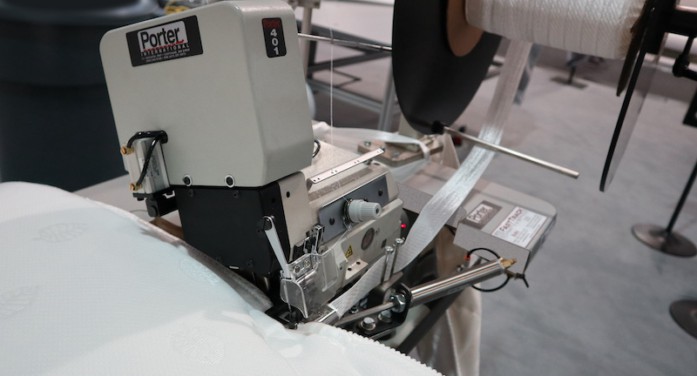
Global Systems Group has enhanced its line with several new machines and features designed for thicker sewn materials, says Randy Metcalf, marketing manager. New machines include the Porter Ultra HC-401 heavy-duty binding machine, designed to join thick border materials to thick quilt panels or nonwoven decking materials. This strong binder can sew through thick borders even with a vertical handle sewn into the tape line, according to the company. “As mattress designers seek new styles to differentiate themselves from the competition, they can’t be restricted by low-level capabilities of their machines,” Metcalf says.
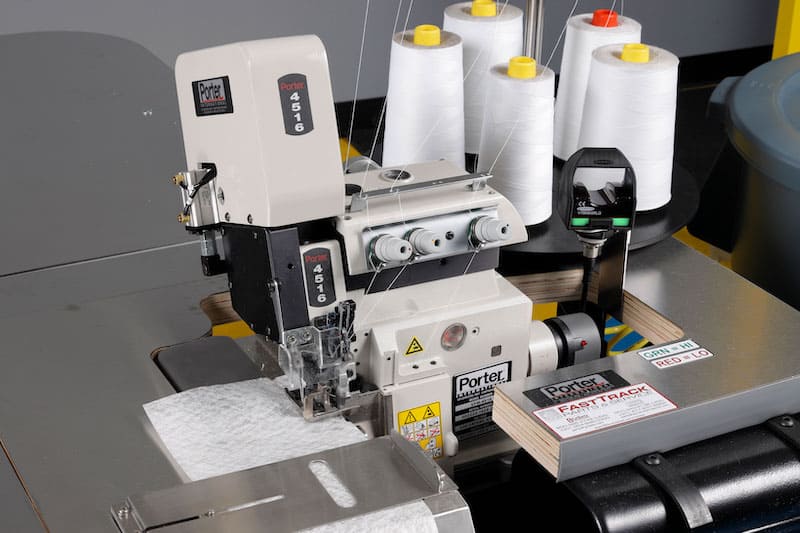
Also new to the GSG line is the Porter VFM-4516 Hi-Lo Flanger, designed to sew thick or thin goods. It is built on the same walking foot technology that Porter International flangers have used for decades. But the VFM-4516 features one key difference, Metcalf says: It allows an operator to “easily switch between the thickest and thinnest products with the simple touch of a button.”
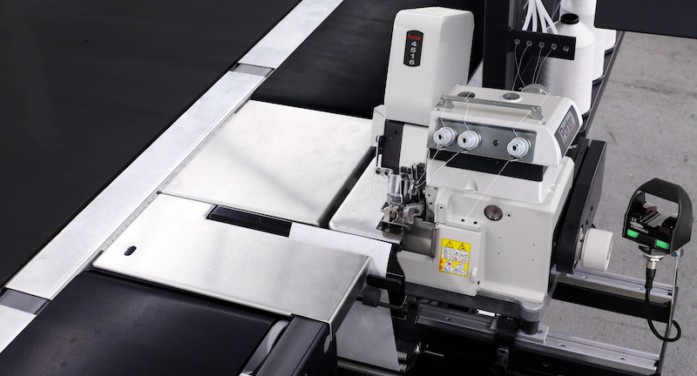
In addition to these new sewing machines, GSG has included new features on several other models. The Porter EST-501, a semi-automatic belt table flange system, now is available with the new VM-4516 sewing head, enabling an operator to process thick or thin goods on the same machine. The EST-501 also automatically turns the mattress quilt panel during the sewing process so the operator can produce high-quality finished goods with minimal skill and effort.

Another product drawing attention at GSG is the Porter POQ-960 long-arm quilt repair machine, Metcalf says. The strong sewing head of the POQ-960 enables operators to sew quilt repairs on the industry’s thickest and densest materials. “The ability to recover these heavy panels is a great cost-savings advantage since they consist of some very expensive fill and ticking materials,” he says. “Scrapping them due to a nonrepairable flaw can add up to very costly wasted resources.”
Simplifying FR Sock Closure

The H238 Pronta Automatic Sock Closer, new from Atlanta Attachment, performs complete fire-retardant sock application in a single automated process. What once took several steps and different work centers now can be completed at one workstation, according to the company. The fully automated operation detects core dimensions as it adjusts, wraps and sews an FR sock to each individual foam or latex mattress. The H238 Pronta is capable of producing one encased mattress every minute. The machine applies the FR sock without the need for glue in the closing process and results in an FR barrier with cleaner lines than is typical, according to the company. The H238 Pronto can be connected to conveyors supplied by Atlanta Attachment, as well as conveyors from other manufacturers.
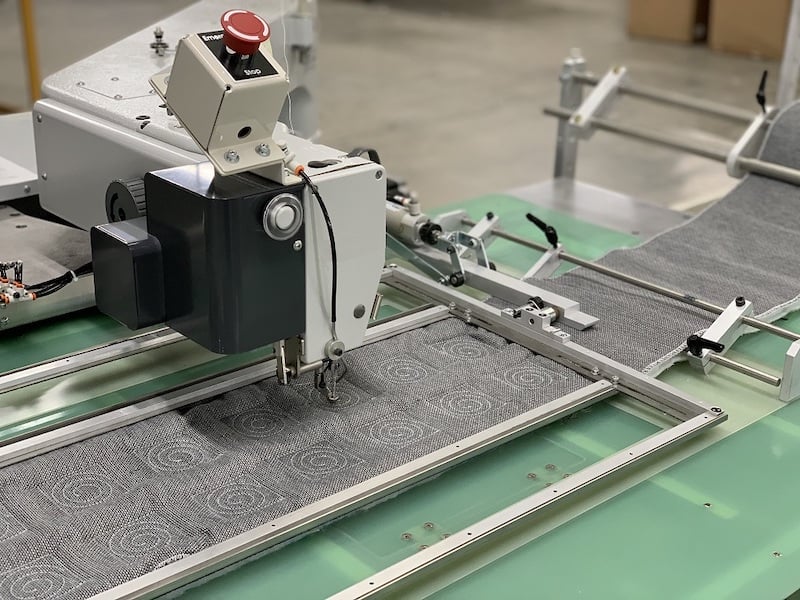
Also new from Atlanta Attachment is the 13551 Decorative Border Workstation, which expands the creative boundaries of border production to include more detailed designs, simulated tufted patterns and even custom logos. The custom programmable pattern spacing offers virtually unlimited design potential, giving mattress makers the ability to create more unique products, according to the company. The machine accommodates borders as tall as 18 inches and automatically detects skipped stitches and broken threads.
Enhancing Productivity and Accuracy

Introduced in 2020, Elektroteks’ Hemmer panel hemming machine quickly has become one of the bestsellers in the company’s line. The Hemmer automates one of the most time consuming parts of mattress production, combining into one highly efficient operation the panel cutting and edge hemming that takes place after quilting.
“The conventional flanging process involves a lot of labor and results in inaccuracy in the end sizes of the panel,” says Serkan Güler, chief executive officer. “With our approach, the Hemmer automatically hems and then cuts, resulting in more accurate hemming and less waste.”
By completely automating this stage of production, the Hemmer eliminates the volume of wasted material created by conventional flanging, which can run as high as 4%, according to the company. Elektrotek’s Hemmer can be synchronized with any multineedle quilter and is able to feed quilted rolls directly.
Rightsizing the Work
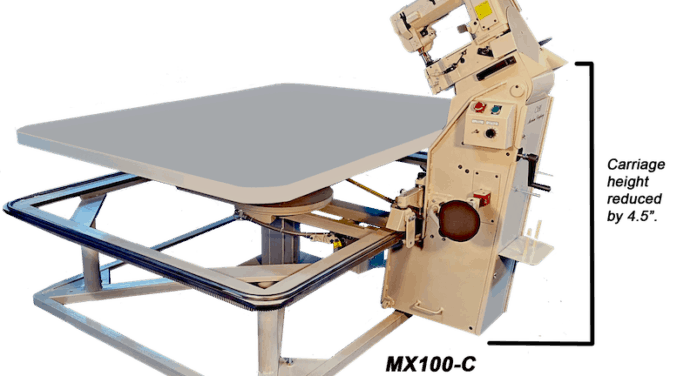
With labor shortages impacting everything from construction to food service, the ability to hire and retain skilled employees is becoming increasingly critical for every business, including those in the sleep products industry. Finding the right tape-edge operator can be especially challenging, and the fact that some machines can be hard for shorter employees to manage makes the process even harder. To address this concern, James Cash Machine Co. has developed the MX100C machine with a shorter, compact carriage that eases operation for employees who are shorter.
The carriage is 4 ½ inches shorter than the traditional MX100 carriage, giving the operator greater visibility and control, as well as an increased ability to reach the area being stitched. As with the MX100, the MX100C features easy-to-use controls, electronic braking, a minimized electrical system that maximizes uptime, smooth automatic corner slowdown, and adjustable kneepad and table height. The machine, built in the United States, will accommodate mattress heights from 3 ½ inches to 24 inches.
In addition, James Cash recently has begun manufacturing several products from the former D.R. Cash line, including the BT96 buildup table and BT15 foam encasement table. James Cash also is in the process of evaluating an optional tape-edge head for its tape-edge machinery to provide a less expensive alternative for customers and is exploring new machinery developments in serging operations.
Speedy Solution

HC 4000, the latest multineedle chain quilting machine from Hengchang Machinery Factory, features several improvements over earlier versions. For starters, the HC 4000 has a more compact design and stronger mechanism, increasing the weight by 40% and making the machine more stable and consistent in its performance. In addition, the HC 4000 now reaches a top speed of 1,350 rpm, which improves both efficiency and the precision of quilting effects, according to the Dongguan, China-based company.
The machine’s power output also has been expanded up to 10 kilowatts, enabling more stable quilting of thicker materials. The height of the press plate is computer controlled with a widescreen display, making it easy to adjust the machine for different quilting thicknesses, the company says.
As for service, the machine features a new automatic lubrication system and no longer uses a timing belt drive. The HC 4000 debuted at the Interzum trade show in Guangzhou, China, in March. The machine is shown here as part of a complete system for fabric quilting, seaming, cutting and panel cutting.
Enhanced Performance and Precision
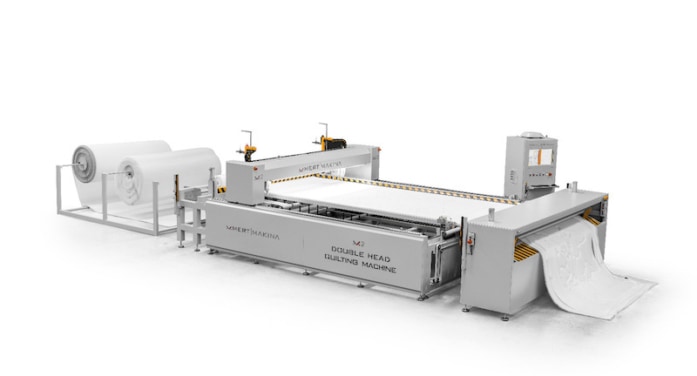
Mert Makina’s latest generation M-2 Single Needle Double Head Quilting Machine produces high-quality mattress panels, along with textiles for a wide range of other industries, including automotive and furniture, according to the company. The machine is designed to work with thin layers of jacquard, knit, silk and cotton fabrics, as well as memory foam and latex up to 4 inches thick. Equipped with an automatic feeding system, the M-2 works as fast as 3,500 rpm for quick, smooth quilting.
Other features include a Siemens Servo motor with automatic controls and an asymmetrical drive system with two Dürkopp Adler 867 sewing heads that deliver superior volume, performance and precision while expanding mattress design capabilities, says Ibrahim Ethem Yildirim, sales and marketing director for the company, which has headquarters in Kayseri, Turkey.
The M-2 also can save producers time and labor costs because it has a cutting system that eliminates the need for separate flanging of bedding panels, the company says. To allow producers to work with more custom patterns and change patterns more quickly, Mert Makina is field testing several other machines.
Complete Quilting and Hemming System
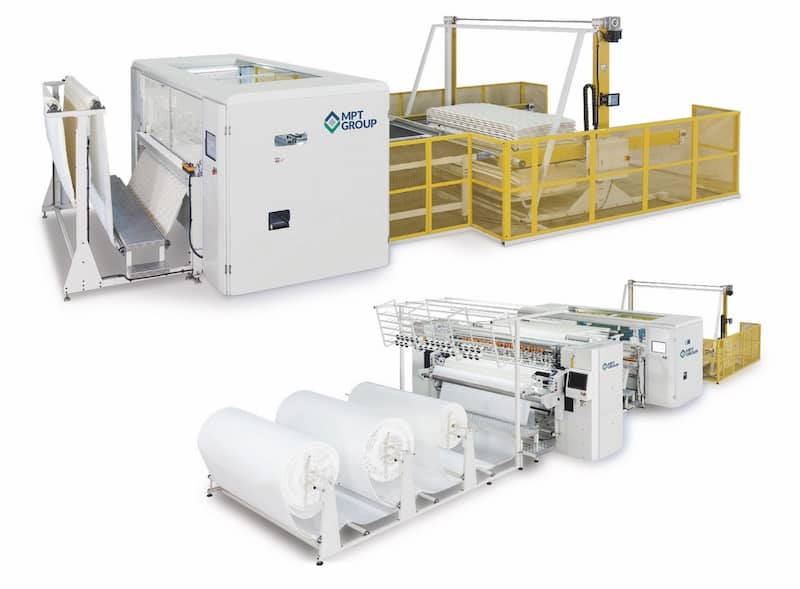
MPT Group says its recently updated iQuilt 2 machine (top) provides mattress producers with a robust multineedle quilting solution. The latest addition to the company’s Matramatic Quilting range, the iQuilt 2 offers a wide variety of patterns, including 180-plus designs that come preinstalled. Designs are grouped together based on fixed needle positions to make pattern selection simple, and an integrated CAD system allows operators to easily modify existing designs or create their own patterns, according to the company, which is based in Bacup, England.
The iQuilt 2 can be installed as a stand-alone machine or integrated with MPT’s Smart-Hem machine (bottom) for a complete quilting and hemming system that eliminates the need for secondary flanging of finished panels.
Smart-Hem is a fully automatic, four-sided hemming station. Panels are processed first through quilting and then automatically hemmed. Features include double-lock chain-stitch sewing, a Windows operating system with digital adjustments for accurate sizing, and a built-in waste removal system. Also available is an optional stacking system that allows for easy movement of finished panels through the manufacturing operation.
Swift, Accurate Tufting

The Hector automatic tufting system, available from Styrteknik Europe AB, provides fast and accurate tufting of polyurethane foam and latex, as well as fiber-filled mattresses, according to the company, based in Helsingborg, Sweden. Styrteknik is represented by P. Bjerre Inc. in Carver, Minnesota.
The system features one or two Hector Long-Armed Machines, positioned opposite each other with a conveyor in between. Via photocell control, mattresses are fed into position on the conveyor and automatically tufted. When equipped with two Hector Long-Armed Machines, the system can individually tuft two single mattresses at one time or team up to tuft one mattress in tandem. The conveyor eliminates time-consuming loading and unloading of mattresses and allows them to flow through the tufting process quickly, the company says. The distance between the Hector machines is automatically controlled by a positioning system that makes it possible to program any distance and number of tufts per row. The computer can store different patterns for various types and sizes of mattresses.
Normal capacity is eight tufts to 10 tufts per sewing head per minute depending on the tufting pattern and stitch length, according to the company. Maximum width is about 79 inches with two sewing heads and 47 inches for one head.
Raising the Bar on Flanging

Introduced in 2020, United Mattress Machinery’s UM-FM-5000 flange machine features improved walking foot technology, an enhanced linkage design and 135 fewer parts in the pressure and needle height systems, the company says. The machine can sew panels from 3/8 inches to 6 inches thick, with a maximum sewing speed of 3,200 rpm. More than 20 of the key sewing components, such as loopers, knives, needle guards and the walking foot linkage assembly, are coated with the company’s patented PTP surface treatment and backed by a one-year guarantee.
“Our goal was to build a machine from the ground up instead of doing modifications over what people have done in the last three decades,” says Mike Porter Sr., chief executive officer and chair of the company, which is based in Delray Beach, Florida. To build “the ultimate flange machine,” he says, United focused on improving three key elements — the feeding mechanism, the pressure system and needle heights. For its feeding mechanism, United went with a walking foot system, which Porter feels is “much better than belt systems.” The second element — United’s pressure system — consists of just four components rather than dozens of custom parts, which can make other machines “complicated and hard to maintain,” Porter says. The UM-FM-5000 also offers higher needle heights, enabling bedding producers to flange thicker panels with ease.




